| (insert your NIE or newspaper logo here) | Weekly Online LessonOnline Lesson ArchiveGrade Level: 7-10
|
The Future of the Arctic National Wildlife Refuge
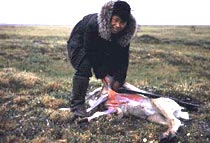 Alaska is home to a unique mix of plants, wildlife, and native
peoples. Referred to as the land of the midnight sun, this region gets
only about four months of sunlight during which plants can grow and
animals can reproduce.
Alaska is home to a unique mix of plants, wildlife, and native
peoples. Referred to as the land of the midnight sun, this region gets
only about four months of sunlight during which plants can grow and
animals can reproduce.
Before the takeover by foreign governments, the native villages depended solely upon subsistence -- living off the land's natural resources for survival in a direct and sustainable way. Indigenous foods, for example, include berries, caribou, and fish.
After Alaska officially became a state in 1959, however, oil exploration and development boomed, changing the nature of the land and its people forever.
Initially, small oil reserve discoveries changed the economies and cultures of only relatively isolated locations. It wasn't until 1967, that a single discovery influenced the future of the entire state: the discovery of North America's largest oil field at Prudhoe Bay on the Arctic Coast.
Huge amounts of money began to flow into the state with the construction of the Trans-Alaska oil pipeline in 1974, and production in the field in 1977.
Today, the oil industry contributes about one-third to the state's economy through tax revenues and royalties. These funds support the state's operating budget, plus residents receive annual payments.
 While many native village communities still depend primarily on a
subsistence way of life, a growing number are shifting toward another
way of life -- depending more and more upon cash flow provided by wage-earning
jobs, including those in the oil and gas industry, commercial fisheries,
and tourism.
While many native village communities still depend primarily on a
subsistence way of life, a growing number are shifting toward another
way of life -- depending more and more upon cash flow provided by wage-earning
jobs, including those in the oil and gas industry, commercial fisheries,
and tourism.
While most of Alaska is open for oil production, the Arctic National Wildlife Refuge (ANWR) -- located in the northeastern part of the state -- has been federally protected from these activities since 1960.
This has been agreeable to some native villagers, who want to ensure that the migrating caribou herds won't be affected by such development, and disagreeable to others, who want more jobs.
One provision of the law that established the refuge says that one piece of it -- called the 1002 Area -- could, if decided by Congress, be opened for oil operations.
On Friday, March 16, 2005, a vote in the U.S. Senate was a step forward toward making that happen -- possibly opening the area for full-scale oil production within the next seven to 10 years.
Like many plans to harvest natural resources on a large scale, this move to open ANWR has fueled national debate. Proponents believe that the U.S. will greatly benefit by the oil boost, decreasing our dependence on foreign oil and providing good paying jobs. Opponents believe that the risk for long-term environmental damage strongly outweighs the short-term energy gain.
This debate has been going on for decades, and it will get even hotter as the bill moves next to the U.S. House of Representatives for their vote on the issue.
So for this week's lesson, you'll review some of the facts about ANWR first, then look at the viewpoints of the opposing sides over this issue.
ANWR Basics
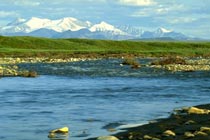 Let's start our exploration of the Arctic
National Wildlife Refuge at the U.S. Fish & Wildlife Service.
Let's start our exploration of the Arctic
National Wildlife Refuge at the U.S. Fish & Wildlife Service.
Check out some of the topics in the Overview, including the Fast Facts, Current Topics, Refuge Features, Maps, and Q&A.
Next, review the Wildlife and Wild Lands in the refuge. What are some of the natural features of this area? What are the different ecological regions?
Under History & Culture, read about Refuge Establishment, Refuge History, and Local Culture.
What were the purposes of establishing ANWR? What important events in the timeline led to the creation of ANWR? How does ANWR relate to the Legacy of Conservation? What are some of the communities adjacent to the refuge? How are the traditional ways of the native peoples tied to their natural environment?
Also at this site, get this government agency's assessement of the issue.
About how much oil is in the Arctic Refuge? What are some of the unique conservation values? What are some of the potential impacts of oil development?
For Oil Development: Fueling Our Future
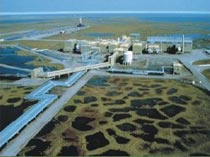 Now, let's dive into the debate by meeting
with the proponents who are lobbying for Jobs
& Energy for America.
Now, let's dive into the debate by meeting
with the proponents who are lobbying for Jobs
& Energy for America.
Start by playing the movie for an introduction to this viewpoint.
Where is the narrator's village in relation to the 1002 Area? How does he, as a native Alaskan, believe that he, his neighbors, and the nation would benefit by oil production in this area?
Explore some of the details, like What is ANWR?, ANWR: the issue, Why open ANWR?, How much oil is there?. Also review Making the Case for ANWR Development.
What percent of ANWR do the proponents say will be developed? About how many barrels of oil could come from the area? What measures would they take to help ensure environmental protection? Why is opening the area to oil production important to America's future? From what sources does the United States get its fossil fuels?
Against Oil Development: Protecting Our Future
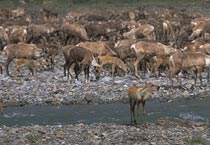 Now
let's visit with some of the opponents of opening ANWR, who want to
Help
Save the Arctic Refuge from oil development.
Now
let's visit with some of the opponents of opening ANWR, who want to
Help
Save the Arctic Refuge from oil development.
Begin with the movie.
What do the opponents say would be some of the dangers in opening the refuge area for development? Which of their statements do you think are the strongest in supporting their case? How do those compare with related statements by the proponents?
Next, review some of the Background Facts, including what the opponents have to say about the Top 10 Oil Industry Myths.
Who would benefit the most from oil development in ANWR? Who or what would suffer the most? In what ways may the American President and his administration be influencing the issue and why?
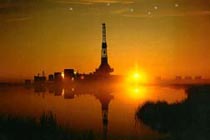 To
learn more details about the ANWR region and this viewpoint on the issue,
let's jump to the website that features the film, Oil
on Ice.
To
learn more details about the ANWR region and this viewpoint on the issue,
let's jump to the website that features the film, Oil
on Ice.
Watch the Short Film, then Explore the Issues, related to Community, Wildlife, Wild Lands, and Energy.
While both sides seem to agree that the future of our energy supply is in question, they seem to disagree on the best course to avoid a crisis -- in what ways do their conclusions about the "best options" for our future differ?
In what ways do the proponents and opponents differ in their viewpoints regarding the value of the region's natural resources and the best "use" of those resources? How much do you think public opinion matters?
Newspaper Activities
Browse current issues of The Salt Lake Tribune to follow the debate over the measure that will allow the next step for opening oil development in ANWR. Who is fighting for and against the measure in the House of Representatives and in other parts of the federal government? In what ways are members of the American public responding to recent events? Are there any organized groups of people that are particularly vocal? If so, which ones are lobbying for opening ANWR and which are lobbying against it? What issues are getting the most coverage by the media and why? Do you think the debate is being presented in a balanced way? In addition to news stories, also look in your newspaper's Letters section for any public opinions on the issue.
© Copyright 2005
Learners
Online, Inc.
